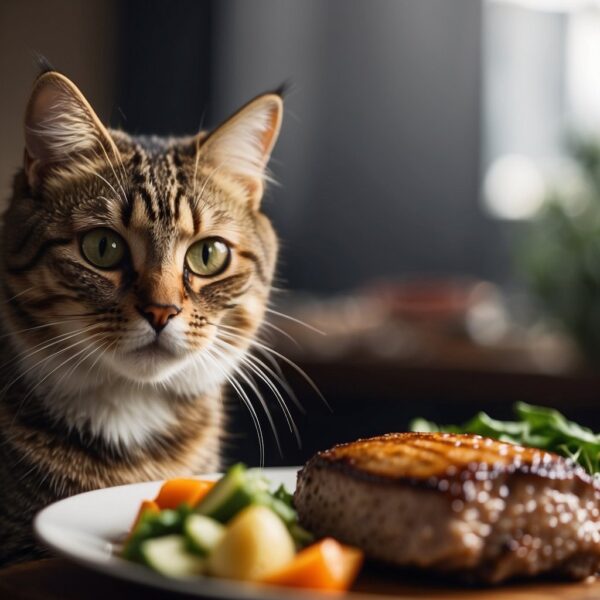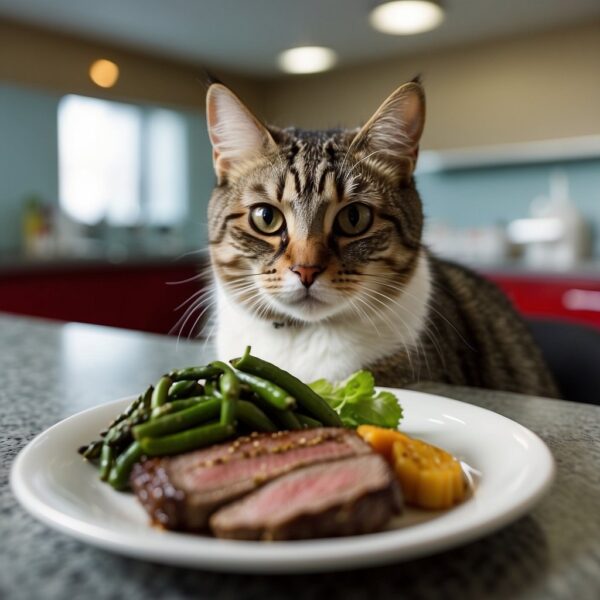
Can Cats Eat Steak? Understanding the Risks
Cats, being obligate carnivores, require a diet rich in animal-based proteins to thrive. Considering their dietary needs, the introduction of steak as a part of their meals might seem like a suitable choice. Steak provides a source of protein that is beneficial to cats, and it is generally safe for feline consumption in moderation. However, it is essential to remember that whilst steak can be a tasty treat, it should not replace a nutritionally complete diet tailored to a cat’s specific health requirements.
Feeding cats steak requires mindful preparation. Cooked steak without any seasonings or sauces is preferred to avoid harmful ingredients often found in human foods. It’s important, however, to not rely solely on steak as a food source. Cats need a balanced diet, which includes a variety of nutrients, vitamins, and minerals to maintain their health. While steak can be incorporated as a supplement, it should not become a staple of a cat’s diet without consulting a veterinarian or a feline nutritionist to ensure their overall dietary needs are fulfilled.
Key Takeaways
- Steak can be a protein-rich treat for cats but is not a complete diet on its own.
- Cooked, unseasoned steak is generally safe for cats in moderation.
- Consultation with a vet is advised to ensure steak is a suitable addition to a cat’s balanced diet.
Can Cats Eat Steak safely?
Cats can safely eat steak if it’s given in moderation and prepared correctly. This protein-rich food offers certain benefits but also carries potential health risks that must be managed carefully.
The Benefits of Steak for Cats
Steak is a beneficial source of protein which is crucial for a cat’s muscle maintenance and overall health. It also provides essential nutrients like iron, zinc, and vitamin B12, which are vital for a cat’s wellbeing.
- Protein: Maintains healthy muscles
- Iron: Supports oxygen transportation in the blood
- Zinc: Aids metabolism and immune function
- B12: Necessary for nerve function and blood cell production
Potential Risks and Health Concerns
Feeding cats steak can lead to health risks such as obesity if portion control is not exercised due to the high calorie content of red meat. Furthermore, allergies to beef are not uncommon in cats. Overconsumption of steak can also upset a cat’s digestive system, leading to discomfort and other issues.
- Obesity: Caused by calorie-dense foods
- Allergies: Can manifest with symptoms like skin irritation and gastrointestinal problems
- Digestive System: May be disrupted by fatty meats that are harder to digest
Comparing Cooked vs. Raw Steak
Cooked steak is generally considered safer for cats to consume than raw meat, as cooking kills harmful pathogens like E. coli and salmonella which can cause serious illness. However, it must be served without any seasonings or sauces as these can be toxic to cats.
- Cooked Steak: Safer due to elimination of bacterial contamination
- Raw Meat: Risky due to potential for pathogens like E. coli and salmonella
Appropriate Portions and Frequency
Cats should only eat steak in moderation as part of a balanced diet that primarily consists of high-quality cat food. The steak should be a supplement rather than a staple, ensuring that cats do not consume excessive calories and fat.
- Moderation: Small, infrequent portions to avoid obesity and diabetes
- Calories: Limited to prevent excessive weight gain
- Supplement: Steak should complement, not replace, a nutritionally complete cat diet

Precautions When offering Steak for Cats
Feeding steak to cats can be a nutritious treat when done correctly, but certain measures are essential to prevent health issues. Cat parents must consider bone removal, avoiding additives, and monitoring for potential allergic reactions.
Removing Bones and Excess Fat
When offering steak, bones must be removed to avoid choking hazards. Small, sharp fragments can damage a cat’s digestive tract. Additionally, excess fat should be trimmed because a high-fat diet can lead to pancreatitis and obesity in cats.
- Bone: Remove all bone fragments.
- Fat: Trim fat to maintain a balanced diet.
Avoiding Harmful Additives
Cats have sensitive digestive systems, and many common seasonings and additives are toxic to them. Garlic, onion, salt, and other spices can cause gastrointestinal irritation, leading to vomiting or diarrhea. Therefore, steak should be served plain, without any added ingredients harmful to feline health.
- Avoid:
- Garlic
- Onion
- Salt
- Additional spices or seasonings
Understanding Allergic Reactions
While allergies are less common, cats can show allergic reactions to certain foods. After introducing steak, monitor for signs of an allergic reaction in cats, which can include vomiting, diarrhea, or skin issues. Should any of these symptoms occur, discontinue feeding steak and consult a veterinarian.
- Signs of allergies may include:
- Skin irritation
- Gastrointestinal upset (vomiting, diarrhea)
Incorporating Steak into a Balanced Diet
A cat’s diet should primarily consist of high-quality, commercial cat food designed to cater to their nutritional needs. When considering steak for cats, it’s crucial to ensure it is used in moderation and complements a balanced diet.
Mixing with Commercial Cat Food
Steak can be incorporated into a cat’s diet by mixing it with commercial cat food. It’s important to choose lean cuts and to cook the steak thoroughly to avoid the risk of pathogens. Small, diced pieces of steak can add a protein boost to a meal, but they should not exceed 10% of the cat’s daily caloric intake to maintain a balanced diet.
Steak as an Occasional Treat
Steak can serve as a valuable treat for cats, provided it’s given sparingly and not as a staple of their diet. One should consider steak a luxurious supplement rather than a meal replacement, allowing a cat to enjoy the variety and enhancing mealtime excitement. Due to various potential risks, such as choking hazards and dietary imbalances, always ensure treats like steak don’t constitute more than 5% of the cat’s weekly diet.
Utilizing Supplements and Alternatives
In situations where steak is used, one may need to balance the meal with appropriate supplements to ensure the cat receives all necessary vitamins and minerals. However, a variety of protein sources like fish, turkey, or chicken can provide a more complete set of nutrients. If choosing to provide supplements, it’s recommended to consult with a veterinarian to tailor them to the cat’s specific needs.
By keeping these guidelines in mind, a cat parent can safely include steak in their cat’s dietary regimen without compromising on their overall nutrition and well-being.

Cats with Special Health Conditions
Cats with health issues such as diabetes or pancreatitis require tailored diets. High-fat foods like steak can trigger pancreatitis in susceptible felines.
- Diabetes Management: A cat with diabetes requires a diet low in carbohydrates and high in protein to manage blood sugar levels.
- Digestive Health: Cats who suffer from conditions that affect their digestion may experience vomiting or diarrhea from rich foods, requiring diets formulated to be gentle on their system.
The Impact of Diet on Aging Cats
As cats age, their nutritional needs change. Aging cats benefit from diets that support joint health and maintain steady energy levels. Nutritional imbalances can affect their vitality and contribute to the development of arthritis or other health issues.
- Joint Care: Diets with omega-3 fatty acids can help maintain healthy joints.
- Energy Levels: Aged cats often have lower energy levels, so diets must be energy-dense to prevent weight loss.
Proper nutrition is a decisive factor in a cat’s health, influencing everything from body weight to chronic disease management. While steak can be part of a cat’s diet, it should be offered in moderation and in balance with other nutritional needs to ensure cats remain healthy throughout their lifespan.
Alternative Protein Sources
In addition to steak, cats require a variety of proteins to maintain a well-balanced diet. The following protein sources are essential for providing the nutrients cats need for optimal health.
Poultry, Fish, and Other Meats
Cats benefit greatly from poultry such as chicken and turkey, which are excellent sources of lean protein. These meats are typically lower in calories and fat compared to red meat and serve as staple ingredients in many commercial cat foods. Fish offers vital omega-3 fatty acids, supporting skin, coat, and joint health. However, it’s important that these meat sources are cooked and unseasoned to prevent any health issues.
The Role of Cat Food Varieties
Commercial cat foods are formulated to provide a balanced diet that meets all of a cat’s nutritional needs. They often come in various flavors, incorporating diverse protein sources like red meat, poultry, and fish. This not only caters to feline palates but also ensures that cats receive a broad range of nutrients necessary for their well-being.
- Dry Food: Mainly composed of chicken, turkey, or fish meal.
- Wet Food: Often includes real meat pieces from various protein sources.
- Freeze-Dried or Raw Diets: May contain single-source proteins for cats with specific dietary requirements.
Benefits of a Diverse Diet
A diverse diet corresponding to different protein sources can furnish numerous health benefits for cats. Introducing a variety of proteins can help prevent food sensitivities and ensures a comprehensive profile of amino acids, minerals, and vitamins. A diet abundant in different proteins can support a strong immune system, robust growth and maintenance, and overall vitality.
- Health Benefits:
- Amino Acids: Essential for muscle repair and growth.
- Vitamins & Minerals: Support various bodily functions from vision to blood coagulation.
- Fatty Acids: Contribute to cognitive function and healthy skin and fur.
Can Cats Eat Steak? Frequently Asked Questions
In addressing common inquiries regarding whether cats can eat steak, it is crucial to consider factors such as seasoning, cooking methods, and the type of meat. Here are insights based on these concerns.
Is it safe to feed cats cooked steak?
It is generally safe for cats to consume cooked steak in moderation. Cooked red meat can be a source of high-quality protein for felines, as long as it is prepared without harmful seasonings and cooking methods.
Can cats have seasoned steak, such as those with salt and pepper?
Seasoned steaks, particularly those with salt, pepper, or other spices, are not recommended for cats. Seasonings can pose health risks to felines, potentially leading to stomach upset or more serious conditions.
Are there certain meats that should be avoided in a cat’s diet?
Cats should avoid meats that are high in sodium or contain potentially harmful additives. Processed meats, like sausages and deli meats, can contain spices and other ingredients that are not suitable for feline consumption.
What are the risks of giving cats raw steak?
Feeding raw steak to cats carries risks of bacterial contamination, such as salmonella or E. coli. These bacteria can cause severe illness in cats, which makes it crucial to cook the meat properly before serving.
How can steak be safely prepared for feline consumption?
To safely prepare steak for cats, cook it thoroughly without any added seasonings or sauces. Ensure the meat is plain and cooked to an appropriate internal temperature to eliminate harmful pathogens.
Should the fat from steak be removed before giving it to cats?
While a small amount of fat in steak is not harmful, excessive fat should be removed before offering it to a cat. Too much fat can lead to obesity and other health issues in cats, so lean cuts are preferable.